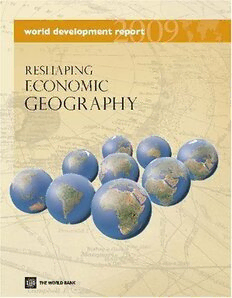
World Development Report 2009: Reshaping Economic Geography (World Development Report) PDF
410 Pages·2008·36.973 MB·English
Most books are stored in the elastic cloud where traffic is expensive. For this reason, we have a limit on daily download.
Preview World Development Report 2009: Reshaping Economic Geography (World Development Report)
Description:
Rising densities of human settlements, migration and transport to reduce distances to market, and specialization and trade facilitated by fewer international divisions are central to economic development. The transformations along these three dimensions - density, distance, and division - are most noticeable in North America, Western Europe, and Japan, but countries in Asia and Eastern Europe are changing in ways similar in scope and speed. World Development Report 2009: Reshaping Economic Geography concludes that these spatial transformations are essential, and should be encouraged.The conclusion is not without controversy. Slum-dwellers now number a billion, but the rush to cities continues.Globalization is believed to benefit many, but not the billion people living in lagging areas of developing nations. High poverty and mortality persist among the world's 'bottom billion', while others grow wealthier and live longer lives. Concern for these three billion often comes with the prescription that growth must be made spatially balanced.The WDR has a different message: economic growth is seldom balanced, and efforts to spread it out prematurely will jeopardize progress. The Report: documents how production becomes more concentrated spatially as economies grow; proposes economic integration as the principle for promoting successful spatial transformations; and, revisists the debates on urbanization, territorial development, and regional integration and shows how today's developers can reshape economic geography.
See more
The list of books you might like
Most books are stored in the elastic cloud where traffic is expensive. For this reason, we have a limit on daily download.
